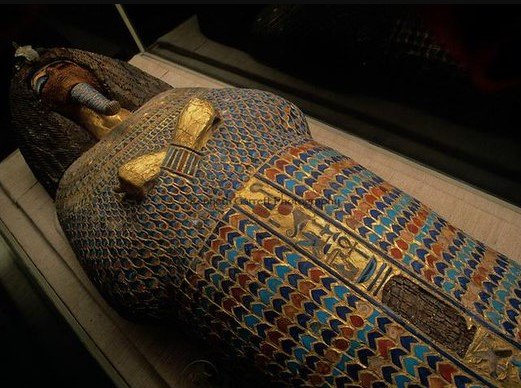Sealed chamber in Asyut reveals the untouched coffin of Idy, a powerful woman from Egypt’s Middle Kingdom
Archaeologists in Egypt have uncovered an untouched burial chamber sealed for nearly 4,000 years — the final resting place of Idy, a priestess and daughter of a powerful regional governor. Her tomb, buried deep beneath the desert floor of Asyut, survived centuries of looting and erosion to offer a remarkably preserved glimpse into Egypt’s Middle Kingdom.
Led by Professor Jochem Kahl of the Free University of Berlin, the team made the discovery in a shaft almost 14 meters deep, hidden behind a wall of quarried stone that had rendered the area inaccessible for decades. The chamber, which housed a coffin inside another coffin, was nestled inside the tomb of Idy’s father, Djefaihapi I, a prominent governor who ruled during the reign of Pharaoh Senusret III, around 1880 BC.
A Hidden Chamber in the Heart of Egypt
The discovery site is located in Asyut, a city roughly 200 miles south of Cairo along the Nile. Once a strategic provincial capital in Upper Egypt, the area is known for its network of rock-cut tombs belonging to governors and elite families of the Middle Kingdom.
This find, though, stands out for one reason: it was missed.
The shaft containing Idy’s remains had long been blocked by a massive quarry wall, assumed to be impenetrable. For years, archaeologists suspected that undiscovered rooms might lie beyond it. But it wasn’t until recently, after painstaking work with ground-penetrating radar and 3D scanning, that the team located the hollow behind the stone.

A Life Etched in Stone and Wood
Inside the chamber, the research team found a rectangular wooden coffin. Inside it was a second, inner coffin—decorated and carved with inscriptions detailing Idy’s titles and lineage. She was labeled “Lady of the House” and “Daughter of the Governor,” honors that confirmed her status in ancient Egyptian society.
The wood itself had decayed, but fragments of paint, resin, and gold leaf clung to the surface, enough to recreate parts of the coffin’s original grandeur. The body, likely Idy’s, was mummified in the traditional style of the time and still rested in a relatively undisturbed position.
Interestingly, while the outer tomb had clearly been broken into by thieves long ago, Idy’s chamber remained almost pristine.
Key findings from Idy’s tomb include:
-
Two coffins, one nested inside the other
-
Beads and faience amulets scattered around the remains
-
Carved canopic jars used to store internal organs
-
Inscriptions detailing her family lineage and religious roles
A Woman of Power in a Man’s World
What makes this find especially fascinating is who Idy was. While female burials from ancient Egypt are not uncommon, high-status tombs of women from this period — especially outside of Thebes — are rare.
Idy was no ordinary woman.
She belonged to a provincial elite that served directly under the pharaoh. Her father, Djefaihapi I, is already well-documented as a powerful official under Senusret III, and his tomb is one of the largest non-royal tombs ever found in Egypt. That Idy’s burial was located within his own tomb structure suggests not just closeness, but importance.
In fact, her burial shaft’s depth and placement suggest deliberate care — perhaps even reverence.
“She may have wielded significant influence in the governor’s court,” said Professor Kahl. “Her burial arrangement and the items found beside her reflect a woman of deep spiritual and political standing.”
Preservation Despite the Centuries
Archaeologists were amazed by how much of Idy’s burial had survived the elements — and human hands.
Despite signs that the broader tomb complex had been raided in antiquity, Idy’s chamber had remained almost completely intact. No torch marks, no broken jars, no upturned bones.
Just dust, silence, and layers of untouched time.
One short paragraph. But it speaks volumes.
Asyut’s Timeline and Importance
To place this discovery in context, here’s a brief table comparing Idy’s burial era with key moments in ancient Egyptian history:
| Time Period | Approximate Date | Notable Figures | Key Features |
|---|---|---|---|
| Old Kingdom | 2700–2200 BC | Pharaoh Khufu | Pyramids at Giza |
| Middle Kingdom | 2050–1710 BC | Senusret III, Djefaihapi I | Provincial expansion, literary flowering |
| New Kingdom | 1550–1070 BC | Ramses II, Hatshepsut | Valley of the Kings, imperial conquests |
| Ptolemaic Period | 332–30 BC | Cleopatra VII | Greek influence, Roman conquest |
Idy lived during the Middle Kingdom’s height — a time of state centralization and elite regional rule. The quality of her tomb speaks to that complexity, and how governors like her father held considerable power outside the royal court.
What Happens Next
For now, the contents of Idy’s tomb are being studied at a nearby conservation facility in Asyut. Egyptian antiquities officials say the objects will eventually go on public display, possibly in the Grand Egyptian Museum in Giza.
Meanwhile, the team is working to stabilize the surrounding tomb structure — still vulnerable to shifts in the limestone hills above. And maybe, just maybe, this opens the door to more discoveries.
Because if Idy’s tomb lay hidden for four millennia, what else lies beneath Egypt’s sands, still waiting?
